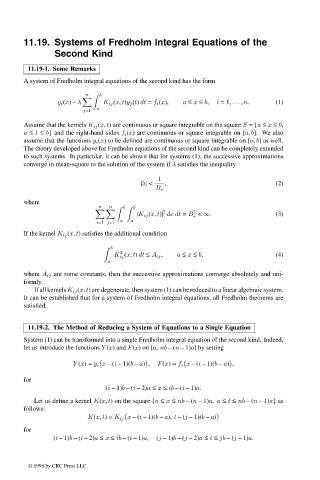Page 609 - Handbook Of Integral Equations
P. 609
11.19. Systems of Fredholm Integral Equations of the
Second Kind
11.19-1. Some Remarks
A system of Fredholm integral equations of the second kind has the form
n b
y i (x) – λ K ij (x, t)y j (t) dt = f i (x), a ≤ x ≤ b, i =1, ... , n. (1)
a
j=1
Assume that the kernels K ij (x, t) are continuous or square integrable on the square S = {a ≤ x ≤ b,
a ≤ t ≤ b} and the right-hand sides f i (x) are continuous or square integrable on [a, b]. We also
assume that the functions y i (x)tobedefined are continuous or square integrable on [a, b] as well.
The theory developed above for Fredholm equations of the second kind can be completely extended
to such systems. In particular, it can be shown that for systems (1), the successive approximations
converge in mean-square to the solution of the system if λ satisfies the inequality
1
|λ| < , (2)
B ∗
where
n n b b
2 2
|K ij (x, t)| dx dt = B < ∞. (3)
∗
a a
i=1 j=1
If the kernel K ij (x, t) satisfies the additional condition
b
2
K (x, t) dt ≤ A ij , a ≤ x ≤ b, (4)
ij
a
where A ij are some constants, then the successive approximations converge absolutely and uni-
formly.
If all kernels K ij (x, t) are degenerate, then system (1) can be reduced to a linear algebraic system.
It can be established that for a system of Fredholm integral equations, all Fredholm theorems are
satisfied.
11.19-2. The Method of Reducing a System of Equations to a Single Equation
System (1) can be transformed into a single Fredholm integral equation of the second kind. Indeed,
let us introduce the functions Y (x) and F(x)on[a, nb – (n – 1)a] by setting
Y (x)= y i x – (i – 1)(b – a) , F(x)= f i x – (i – 1)(b – a) ,
for
(i – 1)b – (i – 2)a ≤ x ≤ ib – (i – 1)a.
Let us define a kernel K(x, t) on the square {a ≤ x ≤ nb – (n – 1)a, a ≤ t ≤ nb – (n – 1)a} as
follows:
K(x, t)= K ij x – (i – 1)(b – a), t – (j – 1)(b – a)
for
(i – 1)b – (i – 2)a ≤ x ≤ ib – (i – 1)a, (j – 1)b – (j – 2)a ≤ t ≤ jb – (j – 1)a.
© 1998 by CRC Press LLC
© 1998 by CRC Press LLC
Page 592

